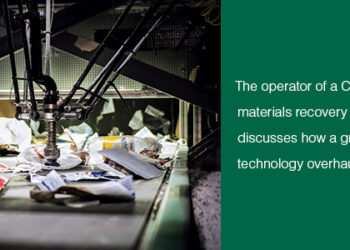In the runup to the 2019 E-Scrap Conference and Trade Show, we are offering up a series of interviews with different industry leaders set to take the stage.

First up is Megan Tabb, director of sales and compliance at Madison, N.C.-based Synergy Electronics Recycling.
As a processing business heavily involved in North Carolina’s state e-scrap program, Synergy has had to regularly make decisions about the best strategies for moving negative-value CRTs downstream. With stockpiles and other developments continuously affecting markets for that material, the E-Scrap Conference session agenda will include a panel featuring Tabb and other CRT experts to help attendees chart their own paths forward.
How big of a challenge are CRTs to manage in 2019?
I can’t speak for everyone, but for us it doesn’t seem to be any bigger a challenge than it has always been. It’s still expensive; we plan for that. I’d say the thing we’re aware of more now than ever (due to the number of companies we’ve all seen make negative headlines) is that we need to be vigilant in terms of monitoring downstream performance. If there’s ever a red flag, we follow up on it, and we take action.
It seems as though downstream options for glass have continued to dwindle. How is the industry responding to this trend?
Existing CRT processors are increasing capacity and expanding downstream outlets, whether it be additional smelters to process funnel glass or additional companies to purchase product. It’s unlikely that we’ll see new CRT processor startups or existing companies investing in new technology, as the stream is slowly but surely drying up.
“You need to ship the stuff downstream as you generate it. Stockpiles never worked out well for anyone.”
So you are seeing clear evidence that the stream is changing?
When we compare year-over-year by month, we’re seeing a definite and consistent decrease in CRT volume percentage and increase in flat-panel volume percentage. That shift has occurred at different times for different localities based on demographics and maturity of their programs. This is really the first year we’ve been able to say that that shift has happened across the board for our residential-collection customers.
What is needed at this point to ensure the CRTs bound for the waste stream are managed properly?
It all starts with good intentions, backed by a good plan, backed by a good backup plan. You must place “doing the right thing” over financial gain. At the same time, you need to be sure you’re charging your customers appropriately so you can afford to work with a responsible CRT processor. And let’s not forget that you need to continually ensure that you’re still working with a responsible CRT processor who is, you know, actually processing CRTs.
Next, you need to ship the stuff downstream as you generate it. Stockpiles never worked out well for anyone. Lastly, you need to have a good contingency plan in place. If your downstream is at capacity, closes or doesn’t pass an audit update, you need to know how your company can quickly and responsibly move on.
Tabb will be speaking on the CRTs in Focus panel, set to take place from 3:30 to 5:00 p.m. on Tuesday, Sept. 24. Other confirmed speakers include Jeff Gloyd, vice president of sales and marketing at URT, and Dan Leif, managing editor of E-Scrap News.
Head to e-scrapconference.com for all the latest details and to register today.






















